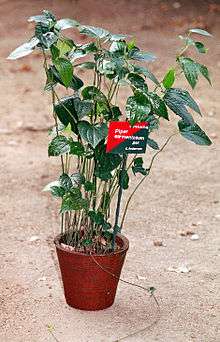Piper sarmentosum
| Piper sarmentosum | |
|---|---|
 | |
| A Piper sarmentosum plant | |
| Scientific classification | |
| Kingdom: | Plantae |
| (unranked): | Angiosperms |
| (unranked): | Magnoliids |
| Order: | Piperales |
| Family: | Piperaceae |
| Genus: | Piper |
| Species: | P. sarmentosum |
| Binomial name | |
| Piper sarmentosum Roxb. | |
Piper sarmentosum is a plant in the Piperaceae family used in many Southeast Asian cuisines. The leaves are often confused with betel,[1] but they lack the intense taste of the betel leaves and are significantly smaller.
Names
There is no "official" English name for it, but it is sometimes called wild betel. It is known as chaphlu (ชะพลู, pronounced [t͡ɕʰá.pʰlūː]) or cha phlu (ช้าพลู, pronounced [t͡ɕʰáː pʰlūː]) in Thai; phak i leut or pak eelerd (ຜັກອີ່ເລີດ) in Lao; and pokok kadok in Malay. In Vietnam, the local name of Piper lolot – lá lốt – is applied to P. sarmentosum also.
Geographic distribution
P. sarmentosum is found from the tropical areas of Southeast Asia, Northeast India and South China, and as far as the Andaman Islands.[2]
In cuisine
P. sarmentosum leaves are sold in bunches and are usually eaten raw.
- In Thai cuisine, the leaves are used to wrap miang kham, a traditional snack; they are also one of the ingredients of the Kaeng khae curry of Northern Thailand.[3] The curry is named after these leaves, which are known as khae in Northern Thailand.
- In Laotian cuisine, it is eaten as part of a salad.
- In Malay cuisine it is shredded for ulam, a type of Malay salad.
Traditional medicine
P. sarmentosum leaves are used in traditional Asian medicines.[4] Chemical analysis has shown the leaves contain the antioxidant naringenin.[5] Amides from P. sarmentosum fruit have been shown to have anti-tuberculosis and anti-plasmodial activities.[6]
References
| Wikimedia Commons has media related to Piper sarmentosum. |
- ↑ "Piper sarmentosum". Asia Food Glossary. Asia Source. Retrieved 2008-09-08.
- ↑ "Piper sarmentosum Roxb. – An addition to the flora of Andaman Islands" (PDF). Current Science. 87 (2). July 25, 2004. Retrieved 2008-09-08.
- ↑ Kaeng Khae Kai (Katurai Chilli Soup with Chicken)
- ↑ Hussain, Khalid; Furqan; Hashmi, Kurshid; Latif, Abida; Ismail, Zhari; Sadikun, Amirin (2012). "A review of the literature and latest advances in research of Piper sarmentosum". Pharmaceutical Biology. 50 (8): 1045–1052. doi:10.3109/13880209.2011.654229.
- ↑ Subramaniam, Vimala. "Natural Antioxidants: Piper sarmentosum (Kadok) and Morinda elliptica (Mengkudu)". Malaysian Journal of Nutrition. 9 (1). Retrieved 2008-09-08.
- ↑ "Chemical constituents and bioactivity of Piper sarmentosum". Journal of Ethnopharmacology. 93 (2–3): 173–6. August 2004. doi:10.1016/j.jep.2004.01.022. PMID 15234750. Retrieved 2008-09-08.